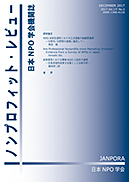Current issue
Displaying 1-6 of 6 articles from this issue
- |<
- <
- 1
- >
- >|
Articles
-
Article type: Article
2022 Volume 22 Issue 1 Pages 1-12
Published: 2022
Released on J-STAGE: February 01, 2023
Download PDF (636K) -
Article type: Article
2022 Volume 22 Issue 1 Pages 13-24
Published: 2022
Released on J-STAGE: February 01, 2023
Advance online publication: November 18, 2022Download PDF (525K) -
Article type: Article
2022 Volume 22 Issue 1 Pages 25-32
Published: 2022
Released on J-STAGE: February 01, 2023
Download PDF (636K) -
Article type: Article
2022 Volume 22 Issue 1 Pages 33-48
Published: 2022
Released on J-STAGE: February 01, 2023
Advance online publication: November 30, 2022Download PDF (661K)
Research Note
-
Article type: Research Note
2022 Volume 22 Issue 1 Pages 49-60
Published: 2022
Released on J-STAGE: February 01, 2023
Download PDF (521K)
Case Report
-
Article type: Case Reports
2022 Volume 22 Issue 1 Pages 61-66
Published: 2022
Released on J-STAGE: February 01, 2023
Download PDF (490K)
- |<
- <
- 1
- >
- >|
